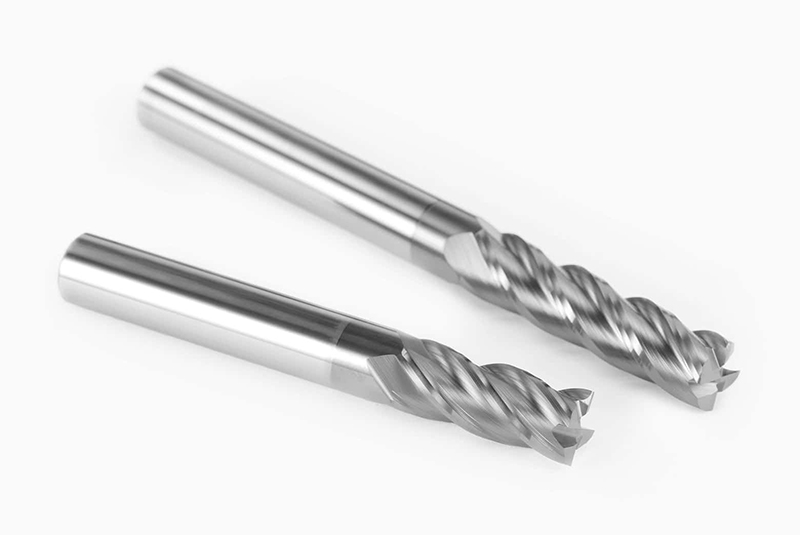Introduction
In metalworking, end mills are among the most versatile cutting tools. However, their design is not optimized for pure axial feeding (e.g., vertical drilling or deep cavity milling). Many engineers and operators overlook this limitation, leading to inefficiencies, shortened tool life, and safety risks. This article explores the technical reasons behind this issue—from tool geometry to machining practices—and proposes optimized solutions.

1. Geometric Design Limitations: Not Built for Axial Cutting
- Lack of Center-Cutting Capability
- Standard end mills (especially 2-flute or 4-flute) often lack cutting edges extending to the center, creating a “dead zone.”
- During axial feeding:
- Central material is squeezed rather than cut, causing:
- Extreme axial resistance.
- Rapid heat buildup (localized temperatures exceeding 1000°C).
- Severe vibration and tool chipping/breakage risks (especially in hard materials).
- Poor Chip Evacuation
- Helical flutes on end mills are optimized for radial chip discharge (sideways ejection), not upward evacuation in deep holes.
- Axial feeding traps chips in the flute, leading to:
- Secondary cutting and accelerated wear.
- Ineffective coolant delivery to the cutting edge.
- Chip clogging and tool jamming in deep-hole machining.
- Weak End-Edge Strength & Heat Dissipation
- End-cutting edges have large relief angles, compromising structural integrity.
- Axial loads stress the weakest part of the tool tip, increasing risks of:
- Micro-chipping or complete edge fracture.
- Thermal degradation (e.g., hardness loss in carbide).
2. Mechanical Risks: Threats to Machine Tools & Workpieces
- Uncontrolled Axial Forces
- Excessive thrust forces from central material挤压 can overload machine spindles.
- Thin-walled components may deform or crack under pressure.
- Reduced Rigidity & Stability
- Long overhangs during deep cavity machining cause tool deflection or “pull-back,” reducing dimensional accuracy.
- Vibration amplifies, worsening surface finish (Ra values increase 2–3x) and triggering chatter.
3. Efficiency & Cost Pitfalls
- Low Material Removal Rate (MRR)
- Axial depth of cut ($a_p$) is limited to 10–20% of tool diameter (e.g., 1–2mm for φ10mm tool), vs. 50%+ for radial cuts.
- Result: Processing time extends 3–5x.
- Dramatically Reduced Tool Life
- End-edge notching, thermal cracking, and chipping occur 5–10x faster under axial loads.
- Case study: An automotive parts manufacturer saw tool life drop from 2 hours (radial) to 20 minutes (axial).
- Hidden Costs
- Spindle bearings degrade 30% faster due to prolonged high loads.
- Downtime from frequent tool changes reduces productivity by 15–20%.
4. Alternatives: Precision Over Compromise
- Pilot Hole Drilling
- Pre-drill a hole slightly smaller than the end mill (e.g., φ9.5mm for φ10mm tool) to eliminate the dead zone.
- Specialized Tools
- Slotting Cutters: Center-cutting edges for axial operations (e.g., keyway slots).
- Drills: Optimized for axial efficiency (50%+ faster MRR).
- Plunge Mills (Corn Mills): Enhanced axial rigidity for deep roughing.
- Optimized Strategies
- Replace “plunge-and-plow” axial layering with helical interpolation or trochoidal milling to leverage radial cutting advantages.
Conclusion: Respect Design Limits to Maximize Productivity
While end mills are versatile, forcing axial feeding is akin to “asking a pianist to play soccer”—functional but inefficient and risky. By aligning tool selection with machining demands, you extend tool life, ensure safety, and unlock machine potential.
Next time axial cutting is needed, remember: The right tool makes all the difference.
Discussion Prompt: Have you encountered tool wear or breakage from axial feeding? Share your experiences and solutions!

